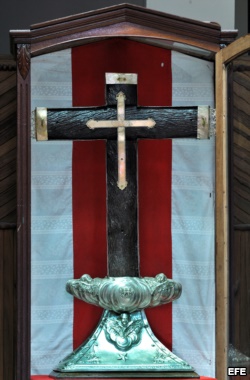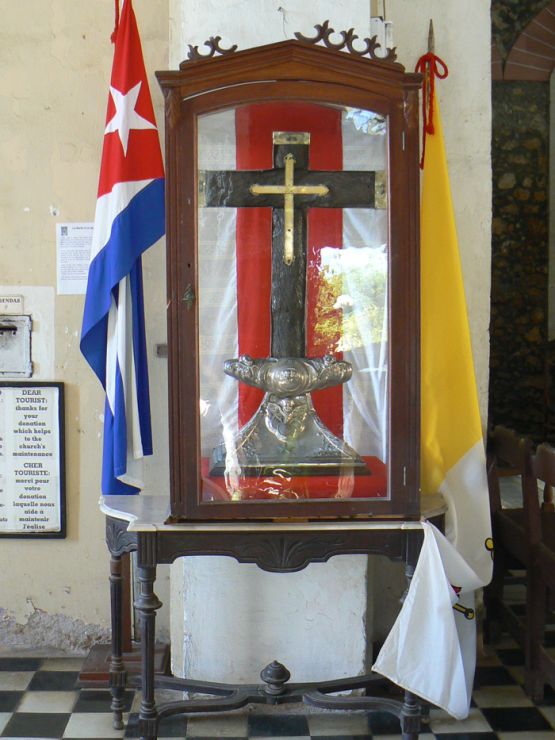 PLANTED BY COLUMBUS, “LA CRUZ DE PARRA”, IS TODAY A TREASURE OF THE NATION.
PLANTED BY COLUMBUS, “LA CRUZ DE PARRA”, IS TODAY A TREASURE OF THE NATION.
“La Cruz de Parra”, is the only one of the 29 similar ones placed by Cristóbal Colón in the lands of America, preserved until the present time, guarded and exhibited, in the parish church of Baracoa in the eastern Cuban province of Guantanamo. Planted by Columbus during his first trip (the first of December of 1492) on these coasts of Cuba is considered the oldest historical-religious relic of the so-called meeting of European and American cultures.
“He placed a large cross at the entrance of that port that he called Porto Santo, on some live rocks,” wrote Fray Bartolomé de las Casas that day, the fourth after his arrival in the province of Baracoa. It is possible that Fray Bartolomé carried out offices with her, although the justifying documentation has not been found, that the first mass given in Cuba was made by the protector of the Indians with her.
Twenty years after being planted, Captain Diego Velázquez, who accompanied Columbus on his second voyage, rediscovered the cross in perfect condition and founded the first village in Cuba, baptized as Our Lady of the Ascension of Baracoa. in 1511.
The cross was later extracted and moved to its current location in the parish church and by 1528 it was being carried out in procession.
Velázquez, captain accompanying Columbus on his second trip to the New World, found in Spain the King Fernando received the title of Adelantado on the island of Cuba, and authorization for the search for gold, the founding of villages and the evangelization of indigenous
To the prized Spanish town, just a village of forty bohíos, Velázquez gave the title of city, gave him his coat of arms, the square, and symbolically installed the first bishopric of the Caribbean nation, with the order of immediate construction of the first cathedral, raised six years later.
Originally it measured about seven feet in length (213.36 centimeters), but with the passage of time it was mutilated because different personalities of Cuban colonial life, each time they visited the city, requested a small piece of it. This happened until the eighteenth century was plated with silver plates, covering their ends, to prevent further destruction.
Currently measuring 67 centimeters in height by 57 in width.
The authenticity of the historic relic was clarified by research conducted by Dr. Raquel Carreras by special order of the National Heritage Directorate and its irrefutable antiquity was certified by the Forestry Institute of Belgium.
The studies of radiocarbon dating to which it was submitted confirmed that the cellular structure of the wood corresponds to the species, Coccoloba diversifolia, coming from the surrounding mountains and that it was built there (Columbus had reached the east coast of the island on the 27th of November) and not brought from Spain, possibly like the other 28 crosses, which at the same time refutes the European origin of the cross.
Throughout the years, the Cruz de la Parra occupies a meritorious place at different crucial moments in the life of the First Villa founded in Cuba. Here was established the First Bishopric that exists in Cuba and the first Catholic Church of the Island; It came out in two large processions that took place when the territory was affected by the 1528 earthquake and the 1529 hurricane.
Pope John Paul II blessed her during her visit to Cuba in 1998.
The “Cruz de Parra” is an identity symbol of Baracoa, declared a National Monument and treasure of the Cuban nation.
 ASENTADA POR COLÓN, “LA CRUZ DE PARRA”, ES HOY UN TESORO DE LA NACIÓN.
ASENTADA POR COLÓN, “LA CRUZ DE PARRA”, ES HOY UN TESORO DE LA NACIÓN.
“La Cruz de Parra”, es la única de las 29 similares colocadas por Cristóbal Colón en tierras de América, conservada hasta la actualidad, custodiada y expuesta, en la iglesia parroquial de Baracoa en la oriental provincia cubana de Guantánamo. Plantada por Colón durante su primer viaje (el primero de diciembre de 1492) en estas costas de Cuba está considerada la más antigua reliquia histórico-religiosa del llamado encuentro de las culturas europeas y americana.
“Asentó una cruz grande a la entrada de aquel puerto que llamó Porto Santo, sobre unas peñas vivas”, escribiría Fray Bartolomé de las Casas de aquel día, el cuarto después de su arribo a tierras baracoesas. Es posible que con ella Fray Bartolomé realizó oficios, aunque no se ha encontrado la documentación justificadora, que la primera misa dada en Cuba la hiciera el protector de los indios con ella.
Veinte años después de haber sido plantada, el capitán Diego Velázquez, quien acompañó a Colón en su segundo viaje, redescubrió, en perfecto estado, la cruz y en ese lugar fundó la primera villa de Cuba, bautizada como Nuestra Señora de la Ascensión de Baracoa en 1511.
La cruz fue posteriormente extraída y trasladada a su actual emplazamiento en la iglesia parroquial y para 1528 ya la sacaban en procesión.
Velázquez, capitán acompañante de Colón en su segundo viaje al Nuevo Mundo, encontrándose en La Española recibió del rey Fernando el título de Adelantado en la isla de Cuba, y la autorización para la búsqueda de oro, la fundación de villas y la evangelización de los indígenas.
A la primada villa española, apenas un caserío de cuarenta bohíos, dio Velázquez el título de ciudad, le otorgó su escudo de armas, la plaza, e instaló simbólicamente el primer obispado de la nación caribeña, con la orden de construcción inmediata de la primera catedral, levantada seis años después.
Originalmente medía unos siete pies de longitud (213.36 centímetros), pero con el paso del tiempo fue mutilada porque diferentes personalidades de la vida colonial cubana, cada vez que visitaban la ciudad, solicitaban un pequeño pedazo de la misma. Esto ocurrió hasta que en el siglo XVIII fue enchapada con planchas de plata, que cubren sus extremos, para evitar su posterior destrucción.
Actualmente mide 67 centímetros de altura por 57 de ancho.
La autenticidad de la histórica reliquia quedó aclarada mediante investigaciones realizadas por la doctora Raquel Carreras por encargo especial de la dirección de Patrimonio Nacional y su irrefutable antigüedad fue certificada por el Instituto Forestal de Bélgica.
Los estudios de datación radiocarbónica a que fue sometida confirmaron que la estructura celular de la madera corresponde a la especie, Coccoloba diversifolia, proveniente de las montañas circundantes y que fue construida allí mismo (Colón había llegado a la costa Este de la isla el 27 de noviembre) y no traída de España, posiblemente al igual que las otras 28 cruces, lo cual a la vez refuta el origen europeo de la cruz.
A lo largo de los años, la Cruz de la Parra ocupa meritorio lugar en diferentes momentos cruciales de la vida de la Primera Villa fundada en Cuba. Aquí se asentó el Primer Obispado que existe en Cuba y la primera Iglesia Católica de la Isla; salió en dos grandes procesiones que tuvieron lugar cuando el territorio se vio afectado por el terremoto de 1528 y el huracán de 1529.
El Papa Juan Pablo II la bendijo durante su visita a Cuba en 1998.
La “Cruz de Parra” es un símbolo identitario de Baracoa, declarada Monumento Nacional y tesoro de la nación cubana.
Agencies/RHC/Guadalupe Y. Díaz/Lorena Viñas/ Internet Photos/ Arnoldo Varona/ TheCubanHistory.com
THE CUBAN HISTORY, HOLLYWOOD.








